TensorFlow Quantum
Google AI, declared the release of Tensorflow Quantum(TFQ), an open-source library for the instantaneous prototyping of quantum machine learning prototypes On March 9th, 2020.
This unique framework delivers quantum computing (QC) experimenters the software and formatting mechanisms required for obtaining the strength and opportunities of machine learning to the domain of quantum computing.
This is a real advancement of their offering in the quantum computing software outlets.
Tensorflow, presents strong categories, data structures, and techniques for the design and performance of the combination of quantum-classical models. On one hand, it features quantum computing abstractions that are consistent with the Tensorflow APIs, along with that they also puff the incredible interpretation of quantum circuit simulators.
There are many applications of quantum machines, such as cryptography.
But cryptography is not the greatest potential application scope for quantum computing.
They are also utilized for expanded precision and grew concepts of physics, such as particle-particle interchange, or collisions of atoms with high energy.
An extensive and various collection of potential application sites with these proficiencies can be employed by using TensorFlow. Some of them include:
- drug discovery
- genetic engineering
- chemical engineering and
- material science
- particle physics
- semiconductors
- optical fibers
- photonics
- high-speed communication
We are talking about the most recent advancements made in this field using artificial intelligence and this already got scientists, investigators, and corporation leaders enthusiastic about these models and their applications.
This class of algorithms and instruments supply the real potential of forging and studying the effects of systems that are intractable such as minute particles or even RBC cells in our body.
What is TFQ concentrated on?
The promise of quantum computing has a prolonged history. Nevertheless, there is a growing buzz from researchers to concentrate on useful concerns that will unravel in the upcoming time horizon.
TFQ is created around Cirq, which is developed and optimized for investigating whether different types of architectures are capable of managing useful issues, which are intractable with other traditional digital computing machinery.
Machine learning ML can understand an example of a design and indicate the system’s conduct.
In our day-to-day lives, we notice that classical ML models have demonstrated assurance in embarking on challenging scientific topics, leading to advancements in image processing, forecasting earthquake aftershocks, predicting the type of disaster happening in a certain place using social media posts, and witnessing new exoplanets.
With the recent advancement in the evolution of quantum computing, the growth of recent quantum ML models could have a deep influence on the world’s largest issues, leading to breakthroughs in the regions of therapy, textiles, sensing, and transmissions.
Nevertheless, to date, there has been a shortage of analysis means to locate proper quantum ML measures that can process quantum data and run on quantum computers.
What is a Quantum ML Model?
A quantum model can define and generalize data with a quantum origin.
To understand how quantum data and hybrid quantum-classical models work let us dive into it.
Quantum data shows superposition and entanglement, directing to joint probability distributions that could demand an exponential part of classical computational resources to express or hold data. For example, when we develop Quantum data on quantum processors or sensors networks that contain quantum matter, control, communication networks, metrology, etc.
Basics of Quantum Computing
A quantum computer uses qubits to provide details and intercommunicate. The most significant feature of qubits is that they encode quantum knowledge in both states 0 and 1 rather than classical bits which can only accept values 0 or 1. This represents a qubit that can be in numerous locations at the exact time due to superposition and hold an immense amount of data.
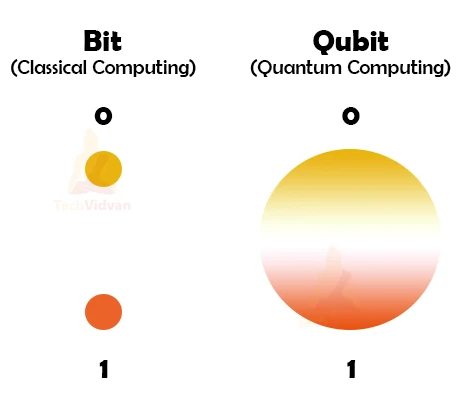
Bra-Ket Notation
This is a generally used inscription to write equations in quantum mechanics and physics.
The notation utilizes angle brackets < > and vertical bar | to create “bras” and “kets” respectively.
A “ket” represents a vector mathematically, in a complicated space v. In physical phrases it denotes the state of a quantum system.
A “bra” signifies a linear function f: V → C which maps an individual vector in V to a digit in complex plane C.
We wrtie a function acting on a vector as (<f| act on a vector |V>):
<f|v> ⍷ C
Superposition
As discussed, qubit stands for quantum binary digit. Qubits can have numerous states at the exact time with the value varying between 0 and 1.
Take the example of the probability that it might rain tomorrow. It can rain or there might also be a chance that it might not rain. In other words, the product will live in two separate states simultaneously.
This is the concept of superposition which is one of the core features of quantum mechanics.
Superposition phrases that Qubits can exist in a mixture of two states simultaneously.
Entanglement
Another essential focus of quantum mechanics is entanglement.
Qubits can be in an entangled fashion if you can’t convey the condition of one qubit without conveying the condition of another- their states cannot be divided.
The Bloch Sphere
Let’s talk about The Bloch Sphere which is the mathematical replica of a qubit. It utilizes a two-dimensional vector with a standard height of one to describe the state of a qubit.
There are two elements of this vector: a real number α and a complex number β.
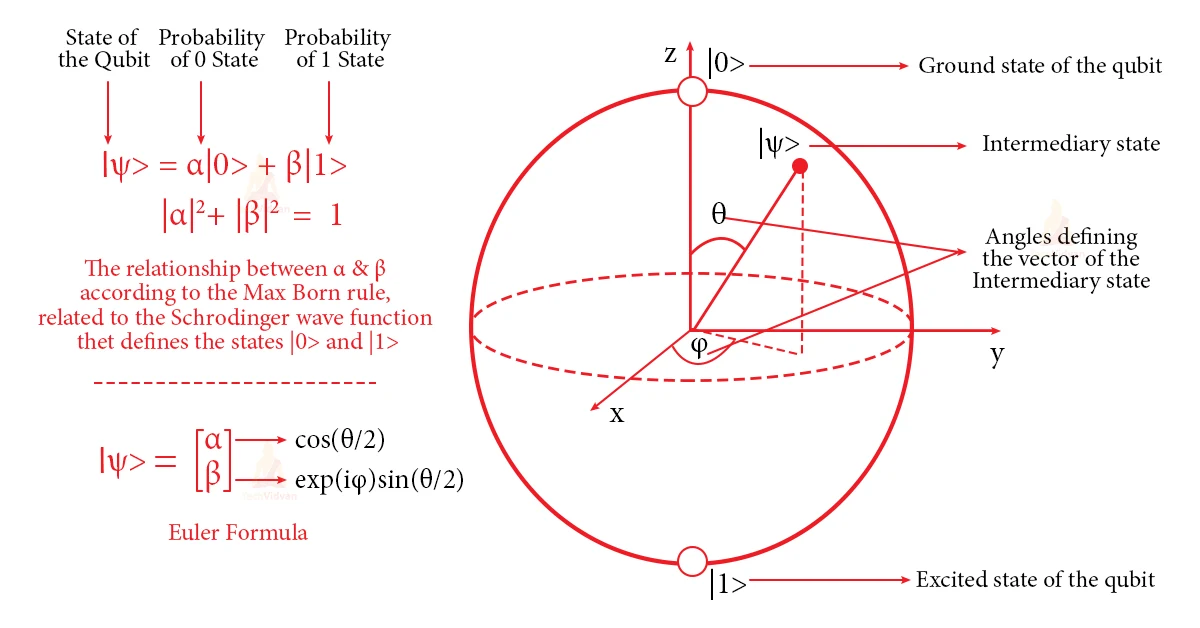
Quantum Decoherence
Another significant spectacle is quantum decoherence. This occurs when qubits superimpose and undesirable collapses occur unsystematically and inherently because of the noise in the design. This directs to errors in computation.
Quantum Coherence allows the quantum computer to process familiarity in a way that classical computers cannot. Quantum Speedup is a quantum algorithm that achieves a stepwise approach to solve a situation, such as exploring a database. It can exceed the best-known classical algorithms.
Quantum Machine Learning(QML) with Algorithms
Quantum computers utilize diverse strategies that are emanated from classical machine learning to crack problems of data science. Below are some of those algorithms:
Quantum Machine Learning for Linear Algebra Problems
Quantum Computers can solve standard linear algebraic problems such as the Fourier Transformation, encountering eigenvectors and eigenvalues.
Below is the circuit diagram for the mentioned algorithm:
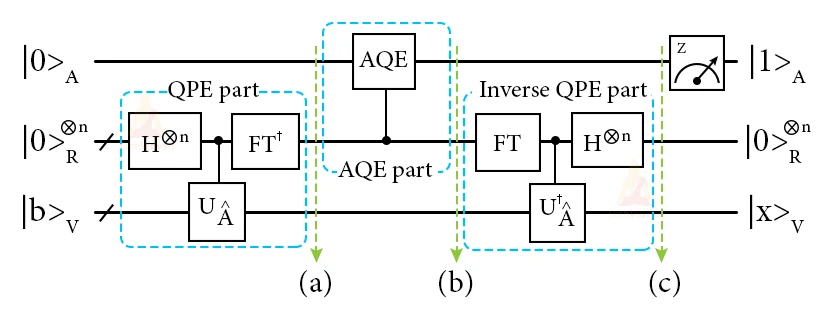
Quantum Principal Component Analysis
Principal Component Analysis (PCA) is utilized for dimensionality reduction and is one of the numerous well-known algorithms in the place of classical machine learning.
Below is a diagram of the quantum circuit for Principal Component Analysis:
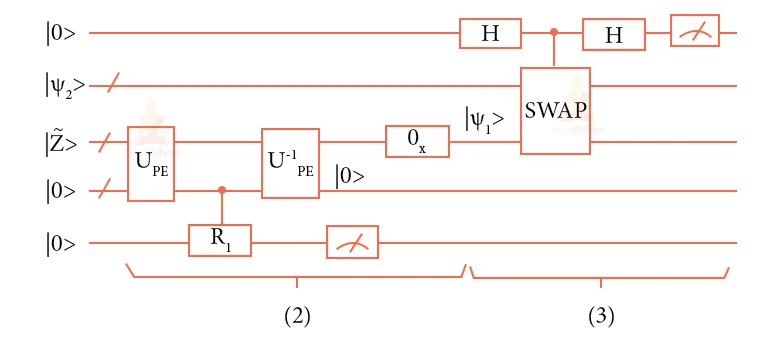
Quantum Support Vector Machines
Support Vector Machine is a classical machine learning algorithm. It organizes the linearly divisible data into two separate classes but if the data is not linearly divisible then it’s superimposed to a more elevated dimension and the dimensionality observes to increase until the data evolves linearly separable.
There’s a problem with constantly improving the dimensionality of the data when it comes to traditional computers because only these computers don’t have sufficient processing power to process high-dimensional data. This is where quantum computing arrives in.
Quantum computers can execute measures for support vector machines at an exponentially quicker rate using the rules of superposition and entanglement.

Quantum Deep Learning
When we integrate Quantum computing with deep learning it decreases the period needed to teach a neural network. When the scope of a neural network expands the time and the need to train it using computational power increases. The answer to this is to emulate classic deep learning algorithms on an existing quantum computer.
Quantum computers function in such a manner that the hardware can simulate a neural network rather than the software utilized in classical computers.
Here, a qubit works as a neuron that includes the fundamental unit of a neural network. Thus quantum computers that have a satisfactory number of qubits can utilize deep learning with an implementation that effortlessly exceeds the deep learning model on a classical computer.
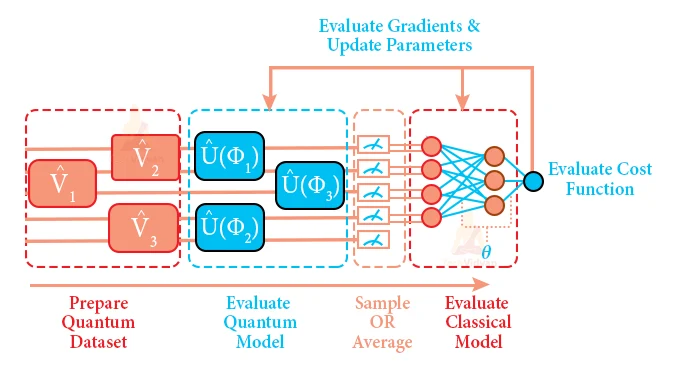
TensorFlow Quantum — What’s the objective?
Quantum computing is a fast-growing specialization that could revolutionize domains like medicine, biology, physics, internet banking, cybersecurity, and numerous more where we need extreme computations.
By facilitating things, every computation that needs time ‘t’ will demand the only logarithm of it. Therefore if something takes 1000 hours on a traditional computer, it will require only 3 hours on a quantum computer.
Those calculations that we calculate on quantum computers, that utilize the fundamental belongings of our world represented by quantum mechanics to our benefit and run computations quicker
But what is the real problem here?
If we look at technical terms, quantum data yielded by NISQ processors are noisy and are generally entangled merely before the measurement appears. Yet, involving quantum machine understanding to noisy entangled quantum data can maximize the extraction of reasonable classical details.
The TFQ library delivers primitives for the growth of models that unravel and interpret correlations in quantum data, extending up possibilities to enhance living quantum algorithms or uncover unique quantum algorithms.
The second idea to present is hybrid quantum-classical models. TensorFlow already helps heterogeneous computing across CPUs, GPUs it is a genuine outlet for testing with a mixture of quantum-classical algorithms.
TFQ combines Cirq with Tensorflow and delivers high-level generalizations for the creation and execution of both biased and productive quantum-classical models by delivering quantum computing primitives consistent with living TensorFlow APIs, along with quantum circuit simulators with high performance.
Cirq also includes powerful machinery that enables users to design efficient algorithms for NISQ devices, such as compilers and schedulers, and allows the execution of hybrid quantum-classical algorithms to operate on quantum circuit simulators, and finally on quantum processors.
How does TFQ work?
TFQ permits researchers to create quantum datasets and quantum models as tensors in a single computational graph.
Now to provide some insight on how quantum ML can help classify “noisy data”.
The researcher does the following:
1. Design a quantum dataset – Quantum data is packed as tensors which is a multi-dimensional array of numbers. Individually quantum data tensor is defined as a quantum circuit documented in Cirq that yields quantum data. The tensor is run by TensorFlow on the quantum computer to develop a quantum dataset.
2. Assess a quantum neural network model – The investigator can prototype a quantum neural network utilizing Cirq that they will subsequently ingrain inside of a TensorFlow compute graph.
TensorFlow Quantum primitives
TFQ has two basic data types:
1. Quantum circuit: Quantum Circuit symbolizes Cirq-defined quantum circuits-cirq which means circuit within Tensorflow. This creates collections of circuits of various dimensions, that contain identical collections of other real-valued data points.
2. Pauli sum: Pauli sum defines linear combinations of tensor products of Pauli operators that we define in Cirq. Like circuits, that produce clusters of operators of diverse sizes.
Different quantum models parameters can specify several general classifications established on the understanding of the quantum data’s structure. The purpose of the model is to achieve quantum processing to extract knowledge concealed in a commonly entangled form.
The quantum model basically separates the input quantum data, defecting the hidden data encoded in classical correlations, thus making it available to classical model processing.
1. Assess Cost Function – Given the consequences of classical post-processing of the model, an estimate of the cost function is given. This is found to check how accurately the model achieves the classification task.
2. Assess Gradients and develop &update Parameters – After considering the cost function, the parameters should correct themselves in a direction desired to reduce the cost.
Advantages of TensorFlow Quantum
1. Complex Problems are solved faster
With the benefit of additional and growing measures, computers with Tensorflow Quantum can achieve calculations within moments of extensive data. quantum computers employ “qubits, but conventional computers use “0” and “1”, which takes more additional time to compute the same data.
2. Managing Extensive datasets
Quantum Computers are developed to handle enormous data within a brief period, which helps more latest technologies like AI and Machine learning programs without blunders and developers are now able to handle large data sets more efficiently.
3. Lookout for Fraud Detection
Numerous banks and economic sectors are utilizing AI. Utilizing the application of Tensor Flow Quantum enables the application to catch frauds.
4. Integration of Numerous datasets
Managing extensive and diverse kinds of data is one of the leading and tough jobs to conduct for any company or institution, occasionally data could be too short or too big. To translate and manage these sorts of data sets Tensor flow Quantum computers can be utilized makes the study more comfortable and quicker.
5. Error Modification
Error correction is one of the primary problems encountered by many organizations. The Tensor flow quantum system is employed to protect and correct.
Applications of Tensorflow Quantum
We use TensorFlow Quantum for hybrid quantum-classical CNN, machine learning to
- quantum control
- layer-wise understanding for quantum neural networks
- quantum dynamics learning
- generative modeling of diverse quantum states
- quantum neural networks using classical recurrent neural networks.
Conclusion
In this article, we wrapped diverse elements of quantum computing beginning from basics to how it can be employed for machine learning. Quantum computing is an emerging field with numerous more findings to be made. The advancement of quantum computing will certainly modify the landscape of machine learning and how the algorithms are executed using classical computing techniques. Enjoy learning!
